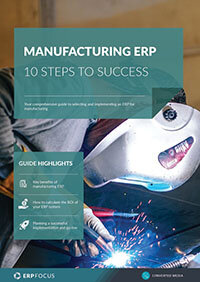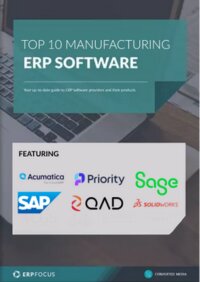How to Gear Your ERP Requirements Toward Lean Manufacturing Processes
Lean manufacturing processes can help your business by reducing costs, enabling more business agility and improving customer satisfaction. Manufacturing ERP can provide a set of tools to help you achieve these goals, but what areas of lean manufacturing can ERP promote and how does this potential translate into a set of ERP requirements.
Defects
Defects include production that fails to meet quality standards but also includes any action that needs to be redone correctly. Look for a manufacturing ERP that supports a quality plan to define incoming material inspections as well as in-line production inspections. Ideally these plans can become part of the production routing and completed by production workers as part of their jobs. Look also for business process tools that can help eliminate errors in accounting and other non-production processes.
Over-Processing
Use your production routing system to ensure only the steps the customer wants are carried out. That last step might make the product shine but only adds value if the customer wants to pay for it. Consider linking production design to your CRM - the feedback received from customers can provide you with a first step in reducing over-processing.
Recommended Reading: 7 Steps to Selecting Process Manufacturing ERP
Outside of production, check if purchase order approvals can be set to match what you need and no more. Requiring a vice president to approve a box of pencils is over-processing.
Transport
Can your manufacturing ERP provide everyone in the enterprise with the information they need, when they need it? If a sneakernet is still required to move documents, your processes are anything but lean. This can be a “quick win” for your ERP requirements process as nearly all ERP systems support complex document management and sharing.
Motion
Ask if the ERP screens can be customized easily on a user-by-user basis. If a user has to tab past a field that your business will not use, that user is wasting motion. Don’t fall for the excuse that it is only a couple of seconds. Those seconds add up and that user is on the payroll.
Waiting
Does the ERP provide information required throughout the enterprise exactly when needed? Is this data real-time, or does the server only push updates twice a day? Lean means no waiting – when it is time to do the job, everything required must be at hand right now.
Inventory
This one is well known. But be sure your manufacturing ERP supports just in time (JIT) ordering and the supplier tracking JIT will require. You may find that implementing JIT lean processes can cause waiting and someone will overproduce next time to create their own buffer - make sure your ERP requirements cover the required inventory controls to prevent this occurring.
Over-Production
If the customer asks for 25, produce exactly 25. Any more is over production and is waste. Your ERP requirements analysis should identify the controls you need to reduce this wastage. Understand how the planning process currently works and plan how it should work once ERP has been implemented. How do you control lot sizes? Can you use a time fence to make exactly what is required over the next weeks and not be limited to produce each customer order individually? Verify you can control printing too. If the ERP forces you to print a job traveler when the job is opened but before it is required to start production, that is over production.
Bottom line? ERP can almost always serve the requirements of lean manufacturing, but identifying the right system for your business and applying it to your lean processes can be a challenge.
Free white paper

Manufacturing ERP: 10 steps to success
Complete step-by-step guide to manufacturing ERP software

Featured white papers
Related articles
-

4 training tips for manufacturing ERP success
These four training tips will help your employees get the most out of your new manufacturing ERP ...
-

CMMC Compliance: What Aerospace and Defense Manufacturers Need to Know
Key insights on CMMC compliance, deadlines, and securing DoD contracts with CMMC 2.0 certificatio...
-

ERP for make-to-order manufacturing
How can ERP help your make-to-order manufacturing business thrive?



